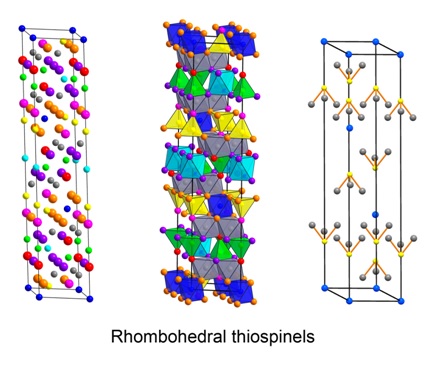Nanosystems: Phys. Chem. Math., 2022, 13 (6), 668–677
Multi-order and structural mechanism of atom nanocluster formation in rhombohedral Cu–Zr-thiospinels
Valeriy M. Talanov – Platov South-Russian State Polytechnic University, Rostov region 346428, Russia; valtalanov@mail.ru
Mikhail V. Talanov – Southern Federal University, Rostov-on-Don, Russia; mvtalanov@gmail.com
Corresponding author: Valeriy M. Talanov, valtalanov@mail.ru
PACS 61.50.Ks, 36.40.-c
DOI 10.17586/2220-8054-2022-13-6-668-677
ABSTRACT A structural mechanism for the formation of nanoclusters and the rhombohedral modification of CuZr1.86(1)S4 has been proposed. Group-theoretical and crystal-chemical methods are used to study the features of the crystal structure and multi-order in Cu–Zr-thiospinel. A multi-order is a structural organization of a material, in the formation of which different degrees of freedom of a crystal participate. It has been proven that the rhombohedral structure of CuZr1.86(1)S4 is formed as a result of displacements and orderings of all types of atoms. It is theoretically shown that the formation of a rhombohedral phase is associated not only with the lattice, but also with the charge and, possibly, orbital degrees of freedom of the crystal. Theory predicts that the rhombohedral phase must be an improper ferroelastic. An important feature of the rhombohedral structure is metal nanoclusters: “bunch” of dimers, trimers, and tetrahedra. Bunch of dimers are an unusual type of self-organization of atoms in rhombohedral spinel-like structures, formed by atoms of two (tetrahedral and octahedral) frustrated crystal sublattices.
KEYWORDS order parameter, multi-order, structural mechanism, rhombohedral modification, nanocluster
ACKNOWLEDGEMENTS The reported study was funded by Russian Science Foundation (RSF) – research projects No. 22-22-00183, https://rscf.ru/project/22-22-00183/
FOR CITATION Talanov V.M., Talanov M.V. Multi-order and structural mechanism of atom nanocluster formation in rhombohedral Cu–Zr-thiospinels . Nanosystems: Phys. Chem. Math., 2022, 13 (6), 668–677.
[In Russian] Валерий М. Таланов и Михаил В. Таланов
Мультипорядок и структурный механизм образования нагнокластеров в ромбоэдрических Cu-Zr-тиошпинелях
АННОТАЦИЯ Предложен структурный механизм образования нанокластеров и ромбоэдрической модификации CuZr1.86(1)S4 Теоретико-групповыми и кристаллохимическими методами исследованы особенности кристаллической структуры и мультипорядка в Cu-Zr-тиошпинели. Мультипорядок представляет собой структурную организацию материала, в образовании которой участвуют различные степени свободы кристалла. Доказано, что ромбоэдрческая структура CuZr1.86(1)S4 формируется в результате смещений и упорядочений всех типов атомов. Теоретически показано, что образование ромбоэдрической фазы связано не только с решеточными, но и с зарядовыми и, возможно, орбитальными степенями свободы кристалла. Теория предсказывает что рассматриваемая фаза должна быть несобственным сегнетоэластиком. Важной особенностью ромбоэдрической структуры являются металлические нанокластеры: «гроздья» димеров, тримеры и тетраэдры. Гроздья димеров представляют собой необычный тип самоорганизации атомов в ромбоэдрических шпинелеподобных структурах, образованный атомами двух (тетраэдрической и октаэдрической) фрустрированных подрешеток кристалла.
КЛЮЧЕВЫЕ СЛОВА параметр порядка, мультипорядок, структурных механизм, ромбоэдрическая модификация, нанокластеры.
